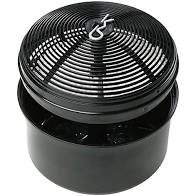One note about : 1) heating the air in your boat interior, 2) circulating the air, as with a small fan, and 3)
dehumidifying the air.
#3 refers ro removing water vapor from the air, and when removed and collected it has to be further removed or emptied from the device. Usually this involves draining a collection tank. Some folks let this device send the collected liquid water into a drain inside the boat like the sink, but that requires leaving a thruhull open. And that's not a good idea for several reasons.
If you bought a device that is labeled a "dehumidifier" and it does not remove water from the air, the label is lying to you.
Usually, inexpensive heater/circulators are sold as 'heaters', and while they will circulate the damp air around, they will not an can not remove the damp.......
One good thing about any air circulation device is that, IF you have a cabin vent open to atmosphere, the humidity can equalize with the outside air, and if the outside air is below freezing the humidity will drop to nearly zero. In my damp and cold area, the ambient air is likely to be in the 40's and the humidity will be well over 60 or 70% for much of the winter. We refer to this as a high "misery index" !

DE-Humidifier note: one winter I checked on a friend's big sailboat every week while he was out of town for a while. He had a real dehumidifier working (110 volt, dockside power supply) and the two gallon tank was full every week. I would lug the tank over to the companionway and empty it into the cockpit. Result was a wonderfully DRY interior. No odors from mildew or mold was present. Cushions dry. Woodwork clean. Awesome.
We have always gone with plan B, as it were. Lots of inside vents and openings to all bilge areas, all upholstery removed to home, and hatches on 'vent' position. I do have an AC portable heater handy to turn on if/when working inside.
Sort of a plan B+, is what a friend on mine does. He has a replacement hatch board with a muffin fan mounted in it and it runs all winter to remove inside air. Actually he uses it a lot in the summer, too.
The "answer" seems to be air active circulation and exchange with outside air, for a host of problems....
The solution might be different in other climates and lattitudes, atmittedly.









